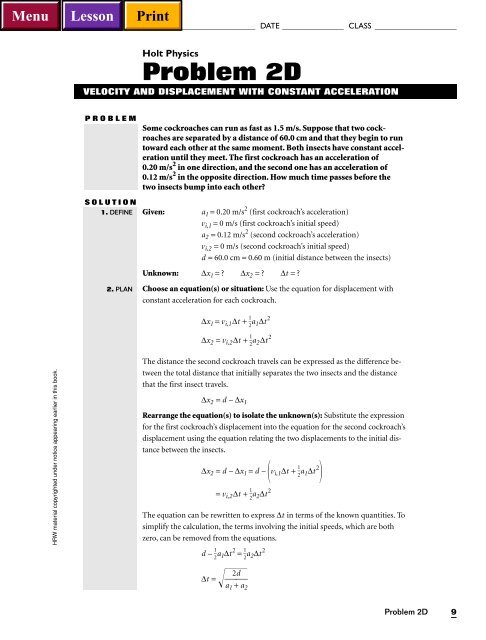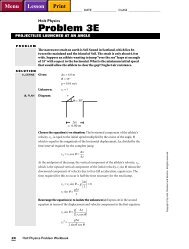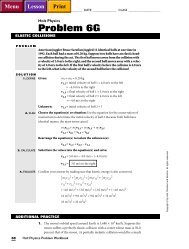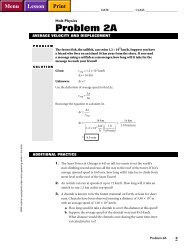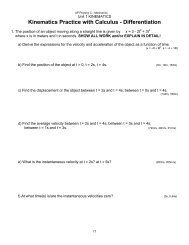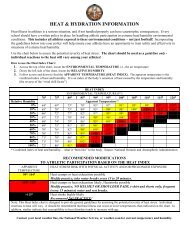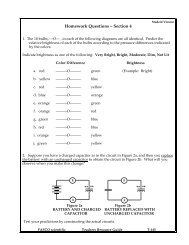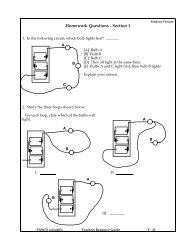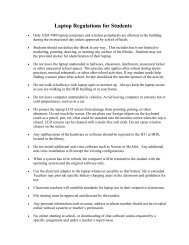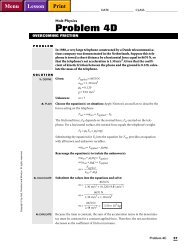Holt Physics Problem 2D - Hays High School
Holt Physics Problem 2D - Hays High School
Holt Physics Problem 2D - Hays High School
You also want an ePaper? Increase the reach of your titles
YUMPU automatically turns print PDFs into web optimized ePapers that Google loves.
HRW material copyrighted under notice appearing earlier in this book.<br />
NAME ______________________________________ DATE _______________ CLASS ____________________<br />
<strong>Holt</strong> <strong>Physics</strong><br />
<strong>Problem</strong> <strong>2D</strong><br />
VELOCITY AND DISPLACEMENT WITH CONSTANT ACCELERATION<br />
PROBLEM<br />
SOLUTION<br />
1. DEFINE<br />
2. PLAN<br />
Some cockroaches can run as fast as 1.5 m/s. Suppose that two cockroaches<br />
are separated by a distance of 60.0 cm and that they begin to run<br />
toward each other at the same moment. Both insects have constant acceleration<br />
until they meet. The first cockroach has an acceleration of<br />
0.20 m/s 2 in one direction, and the second one has an acceleration of<br />
0.12 m/s 2 in the opposite direction. How much time passes before the<br />
two insects bump into each other?<br />
Given: a 1 = 0.20 m/s 2 (first cockroach’s acceleration)<br />
v i,1 = 0 m/s (first cockroach’s initial speed)<br />
a 2 = 0.12 m/s 2 (second cockroach’s acceleration)<br />
v i,2 = 0 m/s (second cockroach’s initial speed)<br />
d = 60.0 cm = 0.60 m (initial distance between the insects)<br />
Unknown: ∆x 1 = ? ∆x 2 = ? ∆t = ?<br />
Choose an equation(s) or situation: Use the equation for displacement with<br />
constant acceleration for each cockroach.<br />
∆x 1 = v i,1∆t + ⎯ 1<br />
2 ⎯a 1∆t 2<br />
∆x 2 = v i,2∆t + ⎯ 1<br />
2 ⎯a 2∆t 2<br />
The distance the second cockroach travels can be expressed as the difference between<br />
the total distance that initially separates the two insects and the distance<br />
that the first insect travels.<br />
∆x 2 = d – ∆x 1<br />
Rearrange the equation(s) to isolate the unknown(s): Substitute the expression<br />
for the first cockroach’s displacement into the equation for the second cockroach’s<br />
displacement using the equation relating the two displacements to the initial distance<br />
between the insects.<br />
∆x2 = d – ∆x1 = d – �vi,1∆t + ⎯ 1<br />
2 ⎯a1∆t 2<br />
�<br />
= v i,2∆t + ⎯ 1<br />
2 ⎯a 2∆t 2<br />
The equation can be rewritten to express ∆t in terms of the known quantities. To<br />
simplify the calculation, the terms involving the initial speeds, which are both<br />
zero, can be removed from the equations.<br />
d – ⎯ 1<br />
2 ⎯a1∆t 2 = ⎯ 1<br />
2 ⎯a2∆t 2<br />
�⎯� a� 2<br />
∆t =�⎯ a� 1<br />
2d<br />
+<br />
<strong>Problem</strong> <strong>2D</strong> 9
NAME ______________________________________ DATE _______________ CLASS ____________________<br />
10<br />
3. CALCULATE<br />
4. EVALUATE<br />
ADDITIONAL PRACTICE<br />
Substitute the values into the equation(s) and solve:<br />
<strong>Holt</strong> <strong>Physics</strong> <strong>Problem</strong> Workbook<br />
∆t =�� = �� =<br />
1.2 m<br />
⎯<br />
0.32 m/s 2<br />
(2)(0.60 m)<br />
⎯⎯<br />
0.20 ⎯ m<br />
s2⎯ + 0.12 ⎯m<br />
s2⎯ 1.9 s<br />
The final speeds for the first and second cockroaches are 0.38 m/s and 0.23 m/s,<br />
respectively. Both of these values are well below the maximum speed for cockroaches<br />
in general.<br />
1. In 1986, the first flight around the globe without a single refueling was<br />
completed. The aircraft’s average speed was 186 km/h. If the airplane<br />
landed at this speed and accelerated at −1.5 m/s 2 , how long did it take<br />
for the airplane to stop?<br />
2. In 1976, Gerald Hoagland drove a car over 8.0 × 10 2 km in reverse. Fortunately<br />
for Hoagland and motorists in general, the event took place on<br />
a special track. During this drive, Hoagland’s average velocity was<br />
about –15.0 m/s. Suppose Hoagland decides during his drive to go forward.<br />
He applies the brakes, stops, and then accelerates until he moves<br />
forward at same speed he had when he was moving backward. How<br />
long would the entire reversal process take if the average acceleration<br />
during this process is +2.5 m/s 2 ?<br />
3. The first permanent public railway was built by George Stephenson<br />
and opened in Cleveland, Ohio, in 1825. The average speed of the<br />
trains was 24.0 km/h. Suppose a train moving at this speed accelerates<br />
–0.20 m/s 2 until it reaches a speed of 8.0 km/h. How long does it take<br />
the train to undergo this change in speed?<br />
4. The winding cages in mine shafts are used to move workers in and out<br />
of the mines. These cages move much faster than any commercial elevators.<br />
In one South African mine, speeds of up to 65.0 km/h are attained.<br />
The mine has a depth of 2072 m. Suppose two cages start their<br />
downward journey at the same moment. The first cage quickly attains<br />
the maximum speed (an unrealistic situation), then proceeds to descend<br />
uniformly at that speed all the way to the bottom. The second<br />
cage starts at rest and then increases its speed with a constant acceleration<br />
of magnitude 4.00 × 10 –2 m/s 2 . How long will the trip take for<br />
each cage? Which cage will reach the bottom of the mine shaft first?<br />
5. In a 1986 bicycle race, Fred Markham rode his bicycle a distance of<br />
2.00 × 10 2 m with an average speed of 105.4 km/h. Markham and the<br />
bicycle started the race with a certain initial speed.<br />
a. Find the time it took Markham to cover 2.00 × 10 2 m.<br />
b. Suppose a car moves from rest under constant acceleration. What<br />
is the magnitude of the car’s acceleration if the car is to finish the<br />
race at exactly the same time Markham finishes the race?<br />
HRW material copyrighted under notice appearing earlier in this book.
HRW material copyrighted under notice appearing earlier in this book.<br />
NAME ______________________________________ DATE _______________ CLASS ____________________<br />
6. Some tropical butterflies can reach speeds of up to 11 m/s. Suppose a<br />
butterfly flies at a speed of 6.0 m/s while another flying insect some distance<br />
ahead flies in the same direction with a constant speed. The butterfly<br />
then increases its speed at a constant rate of 1.4 m/s 2 and catches<br />
up to the other insect 3.0 s later. How far does the butterfly travel during<br />
the race?<br />
7. Mary Rife, of Texas, set a women’s world speed record for sailing. In<br />
1977, her vessel, Proud Mary, reached a speed of 3.17 × 10 2 km/h. Suppose<br />
it takes 8.0 s for the boat to decelerate from 3.17 × 10 2 km/h to<br />
2.00 × 10 2 km/h. What is the boat’s acceleration? What is the displacement<br />
of the Proud Mary as it slows down?<br />
8. In 1994, a human-powered submarine was designed in Boca Raton,<br />
Florida. It achieved a maximum speed of 3.06 m/s. Suppose this submarine<br />
starts from rest and accelerates at 0.800 m/s 2 until it reaches<br />
maximum speed. The submarine then travels at constant speed for another<br />
5.00 s. Calculate the total distance traveled by the submarine.<br />
9. The highest speed achieved by a standard nonracing sports car is<br />
3.50 × 10 2 km/h. Assuming that the car accelerates at 4.00 m/s 2 ,how<br />
long would this car take to reach its maximum speed if it is initially at<br />
rest? What distance would the car travel during this time?<br />
10. Stretching 9345 km from Moscow to Vladivostok, the Trans-Siberian<br />
railway is the longest single railroad in the world. Suppose the train is approaching<br />
the Moscow station at a velocity of +24.7 m/s when it begins a<br />
constant acceleration of –0.850 m/s 2 . This acceleration continues for 28 s.<br />
What will be the train’s final velocity when it reaches the station?<br />
11. The world’s fastest warship belongs to the United States Navy. This vessel,<br />
which floats on a cushion of air, can move as fast as 1.7 × 10 2 km/h.<br />
Suppose that during a training exercise the ship accelerates +2.67 m/s 2 ,<br />
so that after 15.0 s its displacement is +6.00 × 10 2 m. Calculate the<br />
ship’s initial velocity just before the acceleration. Assume that the ship<br />
moves in a straight line.<br />
12. The first supersonic flight was performed by then Capt. Charles<br />
Yeager in 1947. He flew at a speed of 3.00 × 10 2 m/s at an altitude of<br />
more than 12 km, where the speed of sound in air is slightly less than<br />
3.00 × 10 2 m/s. Suppose Capt. Yeager accelerated 7.20 m/s 2 in 25.0 s to<br />
reach a final speed of 3.00 × 10 2 m/s. What was his initial speed?<br />
13. Peter Rosendahl rode his unicycle a distance of 1.00 × 10 2 m in 12.11 s.<br />
If Rosendahl started at rest, what was the magnitude of his acceleration?<br />
14. Suppose that Peter Rosendahl began riding the unicycle with a speed of<br />
3.00 m/s and traveled a distance of 1.00 × 10 2 m in 12.11s. What would<br />
the magnitude of Rosendahl’s acceleration be in this case?<br />
15. In 1991, four English teenagers built an electric car that could attain a<br />
speed 30.0 m/s. Suppose it takes 8.0 s for this car to accelerate from<br />
18.0 m/s to 30.0 m/s. What is the magnitude of the car’s acceleration?<br />
<strong>Problem</strong> <strong>2D</strong> 11
Copyright © by <strong>Holt</strong>, Rinehart and Winston. All rights reserved.<br />
Givens Solutions<br />
4. vi = vavg = 518 km/h<br />
vf = (0.600) vavg ∆t = 2.00 min<br />
5. ∆t = 30.0 s<br />
vi = 30.0 km/h<br />
vf = 42.0 km/h<br />
6. vf = 96 km/h<br />
vi = 0 km/h<br />
∆t = 3.07 s<br />
7. ∆x = 290.0 m<br />
∆t = 10.0 s<br />
vf = 0 km/h = 0 m/s<br />
8. ∆x = 5.7 × 10 3 km<br />
∆t = 86 h<br />
vf = vi + (0.10) vi 9. vi = 2.60 m/s<br />
vf = 2.20 m/s<br />
∆t = 9.00 min<br />
Additional Practice <strong>2D</strong><br />
1. vi = 186 km/h<br />
vf = 0 km/h = 0 m/s<br />
a =−1.5 m/s 2<br />
2. vi =−15.0 m/s<br />
vf = 0 m/s<br />
a =+2.5 m/s 2<br />
vi = 0 m/s<br />
vf =+15.0 m/s<br />
a =+2.5 m/s<br />
vavg = 518 ⎯ � km<br />
1 h<br />
⎯��⎯⎯ ⎯<br />
h 60 min��<br />
1<br />
3<br />
0 m<br />
⎯ = 8.63 × 10<br />
1 km�<br />
3 m/min<br />
∆x = ⎯ 1<br />
2 ⎯(vi + vf)∆t = ⎯ 1<br />
2 ⎯[vavg + (0.600) vavg]∆t = ⎯ 1<br />
2 ⎯(1.600)(8.63 × 10 3 m/min)(2.00 min)<br />
∆x = 13.8 × 10 3 m = 13.8 km<br />
2 ⎯(30.0<br />
1h<br />
km/h + 42.0 km/h) ⎯⎯ (30.0 s) �3600s� m 1 h<br />
⎯�72.0 ⎯k ⎯��⎯⎯ (30.0 s)<br />
h 3600s�<br />
∆x = 3.00 × 10 −1 km = 3.00 × 10 2 m<br />
∆x = ⎯ 1<br />
2 ⎯(v i + v f)∆t = ⎯ 1<br />
∆x = ⎯ 1<br />
2<br />
∆x = ⎯ 1<br />
2 ⎯(v i + v f)∆t = ⎯ 1<br />
2 ⎯(0<br />
1h<br />
km/h + 96 km/h) ⎯⎯ ⎯ �3600s�� 1<br />
3<br />
0 m<br />
⎯ (3.07 s)<br />
1 km�<br />
∆x = ⎯ 1<br />
2 ⎯� 96 × 103 ⎯ m<br />
h ⎯ � (8.53 +×10−4 h) = 41 m<br />
vi = ⎯ 2∆x<br />
⎯ − vf = ⎯<br />
∆t<br />
(2)( 290.0<br />
m)<br />
⎯ − 0 m/s = 58.0 m/s = 209 km/h<br />
10.<br />
0 s<br />
(Speed was in excess of 209 km/h.)<br />
vf + vi = ⎯ 2∆x<br />
⎯<br />
∆t<br />
vi (1.00 + 0.10) + vi = ⎯ 2∆x<br />
⎯<br />
∆t<br />
vi = ⎯ (2)<br />
3<br />
( 5.<br />
7 × 10<br />
km)<br />
⎯ = 63 km/h<br />
( 2.<br />
10)(<br />
86<br />
h)<br />
∆x = ⎯ 1<br />
2 ⎯(vi + vf)∆t = ⎯ 1<br />
2 ⎯(2.60<br />
60 s<br />
m/s + 2.20 m/s)(9.00 min) ⎯ �min ∆x = 1.30 × 10 3 m = 1.30 km<br />
⎯ � = ⎯ 1<br />
∆t = ⎯ vf − vi ⎯ = =⎯<br />
a<br />
−<br />
0 m/s − (186 km/h)� 51.7<br />
m/<br />
s<br />
⎯ 2 = 34 s<br />
−1.5<br />
m/s<br />
⎯ 1 h ⎯�� 3600s<br />
⎯1<br />
3<br />
0 m ⎯� 1 km<br />
⎯⎯⎯⎯<br />
−1.5 m/s2 For stopping:<br />
∆t1 = ⎯ vf − vi 0 m/s − (−15.<br />
0 m/s)<br />
⎯ =⎯⎯ a<br />
2.5<br />
m/<br />
s2<br />
= ⎯ 15.0<br />
m/<br />
s<br />
⎯ 2 = 6.0 s<br />
2.5<br />
m/s<br />
For moving forward:<br />
∆t 2 = ⎯ vf − vi 15.0 m/s − 0.0 m/s 15.0<br />
m/<br />
s<br />
⎯ = ⎯⎯ = ⎯⎯ 2 = 6.0 s<br />
a 2.5 m/s2 2.5<br />
m/s<br />
∆t tot =∆t 1 +∆t 2 = 6.0 s + 6.0 s = 12.0 s<br />
2 ⎯(4.80 m/s)(5.40 × 10 2 s)<br />
Section Two — <strong>Problem</strong> Workbook Solutions II Ch. 2–5<br />
II
II<br />
Givens Solutions<br />
II Ch. 2–6<br />
3. vi = 24.0 km/h<br />
vf = 8.0 km/h<br />
a =−0.20 m/s 2<br />
4. v1 = 65.0 km/h<br />
vi,2 = 0 km/h<br />
a2 = 4.00 × 10 −2 m/s 2<br />
∆x = 2072 m<br />
5. ∆x = 2.00 × 10 2 m<br />
v = 105.4 km/h<br />
v i,car = 0 m/s<br />
6. vi = 6.0 m/s<br />
a = 1.4 m/s 2<br />
∆t = 3.0 s<br />
7. vi = 3.17 × 10 2 km/h<br />
vf = 2.00 × 10 2 km/h<br />
∆t = 8.0 s<br />
∆t =<br />
<strong>Holt</strong> <strong>Physics</strong> Solution Manual<br />
∆t = ⎯ vf − vi ⎯<br />
a<br />
(8.0 km/h − 24.0 km/h)�<br />
∆t =<br />
⎯ 1 h ⎯�� 3600<br />
s<br />
⎯1<br />
3<br />
0 m ⎯� 1 km<br />
⎯⎯⎯⎯⎯<br />
−0.20 m/s2 m 1 h<br />
−16.0 ⎯k � ⎯��⎯⎯ ⎯<br />
h 3600s��<br />
1<br />
3<br />
0 m<br />
⎯<br />
1 km�<br />
⎯⎯⎯<br />
−0.20 m/s 2<br />
= 22 s<br />
For cage 1:<br />
∆x = v1∆t1 ∆t1 = ⎯ ∆x<br />
⎯ = =<br />
v1 For cage 2:<br />
∆x = vi,2∆t2 + ⎯ 1<br />
2 ⎯a<br />
2072 m<br />
⎯⎯⎯ 115 s<br />
(65.0 km/h)�<br />
2<br />
2∆t2 ⎯ 1 h ⎯�� 3600<br />
s<br />
⎯1<br />
3<br />
0 m ⎯� 1 km<br />
Because vi,2 = 0 km/h,<br />
∆t2 =� ⎯2<br />
∆x<br />
�⎯� a2<br />
= �⎯ (2<br />
4. �0� 0<br />
) (<br />
�× 207<br />
�1 0�<br />
−<br />
2<br />
2� m<br />
m� ) ⎯� �2 /s<br />
= 322 s<br />
Cage 1 reaches the bottom of the shaft in nearly a third of the time required for cage 2.<br />
2.00 × 10<br />
a. ∆t = = = 6.83 s<br />
2 m<br />
⎯⎯⎯<br />
�105.4 ⎯ km<br />
⎯�� h<br />
⎯ 1 h ⎯�� 3600<br />
s<br />
⎯1<br />
∆x<br />
⎯v<br />
3<br />
0 m ⎯� 1 km<br />
b. ∆x = v i,car ∆t + ⎯ 1<br />
2 ⎯a car∆t 2<br />
acar = ⎯ 2∆<br />
∆t2<br />
x<br />
⎯ =⎯ (2)(2<br />
2<br />
. 00<br />
× 10<br />
m)<br />
⎯<br />
( 6.<br />
83 s)<br />
2 = 8.57 m/s 2<br />
∆x = v i∆t + ⎯ 1<br />
2 ⎯a∆t 2 = (6.0 m/s)(3.0 s) + ⎯ 1<br />
2 ⎯(1.4 m/s 2 )(3.0 s) 2 = 18 m + 6.3 m = 24 m<br />
a = ⎯ vf<br />
(2.00 × 10<br />
− vi ⎯ =<br />
∆t<br />
2 km/h − 3.17 × 10 2 1 h<br />
km/h) ⎯⎯ ⎯ �3600 s��<br />
1<br />
3<br />
0 m<br />
⎯<br />
1 km�<br />
⎯⎯⎯⎯⎯⎯<br />
8.0 s<br />
1 h<br />
(−117 km/h) ⎯⎯ ⎯ �3600 s��<br />
a = =<br />
1<br />
3<br />
0 m<br />
⎯<br />
1 km�<br />
⎯⎯⎯<br />
8.0 s<br />
∆x = vi∆t + ⎯ 1<br />
2 ⎯a∆t 2 = (3.17 × 10 2 1 h<br />
km/h) ⎯⎯ ⎯ �3600s�� 1<br />
3<br />
0 m<br />
1 km<br />
∆x = (7.0 × 10 2 m) + (−130 m) = +570 m<br />
−4.1 m/s 2<br />
⎯ � (8.0 s) + ⎯ 1<br />
2 ⎯(−4.1 m/s 2 )(8.0 s) 2<br />
Copyright © by <strong>Holt</strong>, Rinehart and Winston. All rights reserved.
Copyright © by <strong>Holt</strong>, Rinehart and Winston. All rights reserved.<br />
Givens Solutions<br />
8. vi = 0 m/s<br />
vf = 3.06 m/s<br />
a = 0.800 m/s 2<br />
∆t 2 = 5.00 s<br />
9. vf = 3.50 × 10 2 km/h<br />
vi = 0 km/h = 0 m/s<br />
a = 4.00 m/s 2<br />
10. vi = 24.0 m/s<br />
a =−0.850 m/s 2<br />
∆t = 28.0 s<br />
11. a =+2.67 m/s 2<br />
∆t = 15.0 s<br />
∆x =+6.00 × 10 2 m<br />
12. a = 7.20 m/s 2<br />
∆t = 25.0 s<br />
vf = 3.00 × 10 2 ms<br />
13. vi = 0 m/s<br />
∆x = 1.00 × 10 2 m<br />
∆t = 12.11 s<br />
14. vi = 3.00 m/s<br />
∆x = 1.00 × 10 2 m<br />
∆t = 12.11 s<br />
15. vf = 30.0 m/s<br />
vi = 18.0 m/s<br />
∆t = 8.0 s<br />
∆t1 = ⎯ vf − vi 3.06<br />
m/<br />
s − 0<br />
⎯ =⎯<br />
a 0.<br />
800<br />
m/<br />
s 2<br />
m/s<br />
⎯ = 3.82<br />
∆x 1 = v i∆t 1 + ⎯ 1<br />
2 ⎯a∆t 1 2 = (0 m/s) (3.82 s) + ⎯ 1<br />
2 ⎯(0.800 m/s 2 ) (3.82 s) 2 = 5.84 m<br />
∆x 2 = v f∆t 2 = (3.06 m/s)(5.00 s) = 15.3 m<br />
∆x tot =∆x 1 +∆x 2 = 5.84 m + 15.3 m = 21.1 m<br />
∆t = ⎯ (v (3.50 × 10<br />
f − vi) ⎯ = = 24.3 s<br />
a<br />
2 km/h − 0 km/h)�⎯ 1 h ⎯�� 3600<br />
s<br />
⎯1<br />
3<br />
0 m ⎯� 1 km<br />
⎯⎯⎯⎯⎯<br />
(4.00 m/s2 )<br />
∆x = v i∆t + ⎯ 1<br />
2 ⎯a∆t 2 = (0 m/s)(24.3 s) + ⎯ 1<br />
2 ⎯(4.00 m/s 2 )(24.3 s) 2<br />
∆x = 1.18 × 10 3 m = 1.18 km<br />
v f = v i + a∆t = 24.0 m/s + (− 0.850 m/s 2 )(28.0 s) = 24.0 m/s − 23.8 m/s = +0.2 m/s<br />
vi ∆t =∆x− ⎯ 1<br />
⎯a∆t<br />
2<br />
2<br />
vi = ⎯ ∆x<br />
∆t<br />
⎯ − ⎯ 1<br />
v i = v f − a∆t<br />
2 ⎯a∆t = ⎯ 6.00<br />
2<br />
× 10 m<br />
15.0<br />
s<br />
⎯ − ⎯ 1<br />
2 ⎯(2.67 m/s 2 )(15.0 s) = 40.0 m/s − 20.0 m/s = +20.0 m/s<br />
v i =(3.00 × 10 2 m/s) − (7.20 m/s 2 )(25.0 s) = (3.00 × 10 2 m/s) −(1.80 × 10 2 m/s)<br />
v i = 1.20 × 10 2 m/s<br />
∆x = vi∆t + ⎯ 1<br />
⎯a∆t<br />
2<br />
2<br />
Because vi = 0 m/s,<br />
a = ⎯ 2∆<br />
∆t<br />
2<br />
x<br />
⎯ =⎯ (2)(<br />
2<br />
1.00<br />
× 10<br />
m)<br />
⎯<br />
( 12.11<br />
s) 2 = 1.36 m/s 2<br />
a = ⎯ 2(∆x −<br />
∆t<br />
2<br />
v<br />
⎯<br />
i∆t) (2)[1.00 × 10<br />
=<br />
2 m − (3.00 m/s)(12.11 s)]<br />
⎯⎯⎯⎯<br />
(12.11 s) 2<br />
a =<br />
(2)(1.00 × 10 2 m − 36.3 m)<br />
⎯⎯⎯<br />
(12.11 s) 2<br />
a = ⎯ ( 2)<br />
( 64<br />
m<br />
( 12.<br />
11<br />
s) 2<br />
)<br />
⎯ = 0.87 m/s 2<br />
a = ⎯ vf − vi ⎯ = =⎯<br />
∆t<br />
12.0<br />
m/s<br />
⎯ = 1.5 m/s<br />
8.0<br />
s<br />
2<br />
30.0 m/s − 18.0 m/s<br />
⎯⎯<br />
8.0 s<br />
Section Two — <strong>Problem</strong> Workbook Solutions II Ch. 2–7<br />
II


